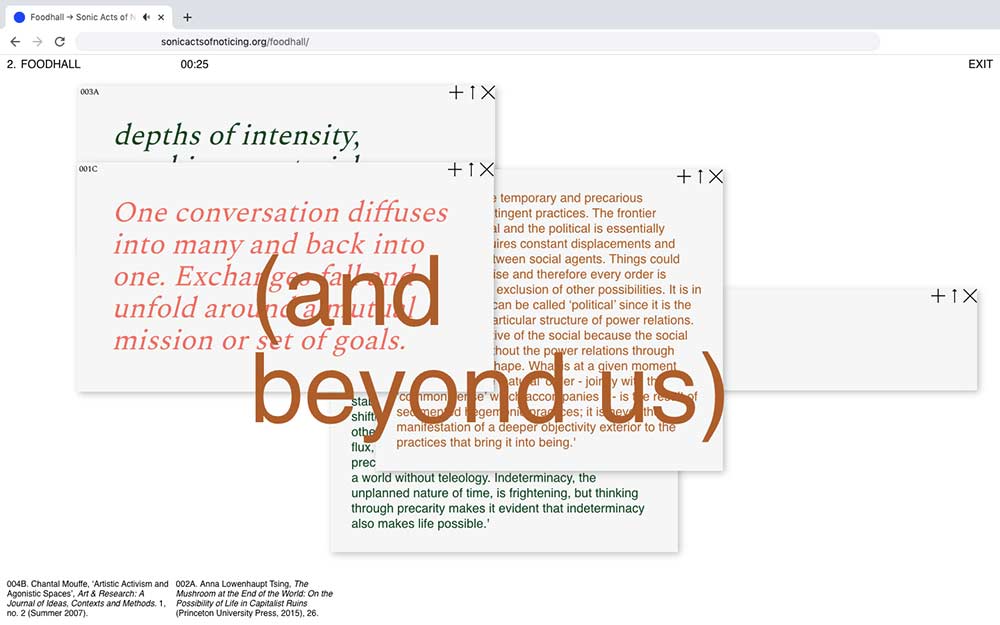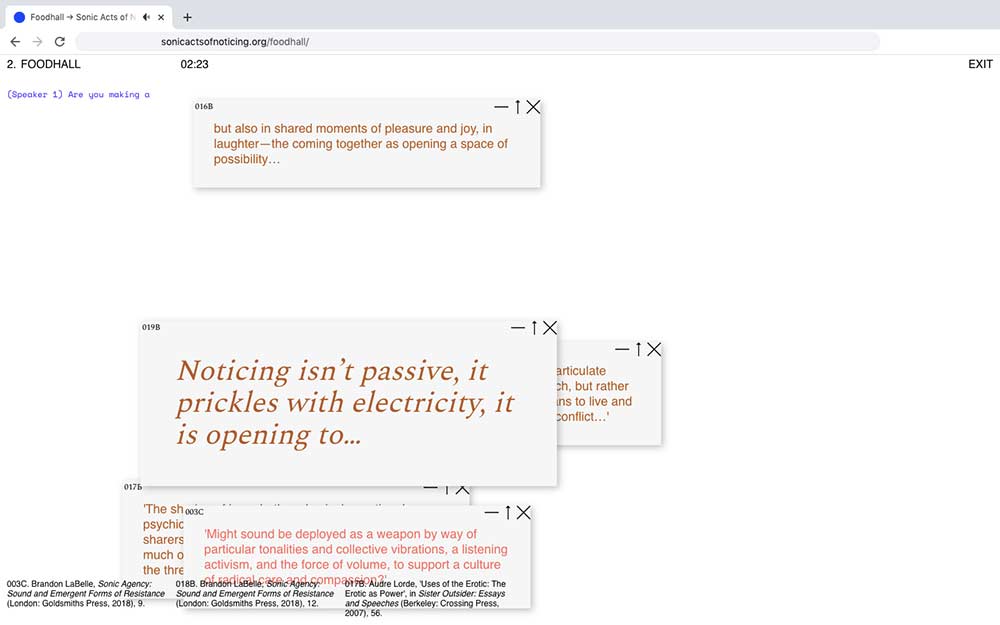- Login
Critical Spatial Practice





We are interested in how listening can be a tool, or a strategy that makes things happen or leads to (political) action. How can listening be understood as a practice that might activate a space and a time which is not purely theoretical, experiential or perceptual, but intrinsically social and political for the reason that it sustains an “other-doing”?
Lucia Farinati and Claudia Firth, The Force of Listening (Berlin: Errant Bodies, 2017), 20.
Sonic Acts of Noticing is an interactive audio-textual environment, where sonic compositions drawn from field recordings of three high street sites collide with textual artefacts that are temporally coded to the audio. Provocations, quotations, and critical and journalistic writing, augment, subvert, amplify, and dissonate listening, in relation to navigations of the site, opening new possibilities and configurations. Following multispecies-anthropologist Anna Lowenhaupt Tsing, we engage in space as patch; an open-ended assemblages of human and non-human activity. Listening allows us to do so with curiosity and openness.
The project develops deep listening as critical? spatial practice. As host to sonic compositions, the Sonic Acts of Noticing site allows us to initiate various forms of collective and personal listening, recording, responding, re-listening, and publishing, in ways that can support creative and critical approaches to design. As you listen, textual artefacts are gathered which become a unique publication mapping a spatio-temporal journey.
We are interested in the potential of listening for architects and spatial practitioners, who are concerned with social and ecological justice and the development of emancipatory space. There is an important feminist political history around listening as a way to create meaningful relations across difference and engage in shared struggles, in the form of ‘consciousness raising’. This work suggests the need for the development of listening as a social practice, where bodies, gestures, situations, and protocols all play a part in the production of political and affective space. Sound produces space not as fixed, bounded, and extensive, but instead emergent, intensive, and relational. Listening in this project operates as a way to gather publics, and pay attention to social relations, without assuming their composition and potentials. This work offers a different point of departure for processes of design, by interrupting images and preconceptions of how space is constituted. Listening is produced as care for an entangled world.
The work – including soundscapes and textual artefacts – can be found here: www.sonicactsofnoticing.org
And a video about the work here:https://vimeo.com/605142451
This project was developed by two architectural designers and educators, a sound artist-researcher, and two web design-researchers. We come together to explore the potential of foregrounding the sonic in the creation of emancipatory spaces. We operate at the intersection of practice, teaching and research; the material, the sonic and the virtual, in order to find modes and sites of intervention that will support collective learning and transformative change. Julia Udall leads fourth year M.Arch at Sheffield Hallam School of Architecture, and third year history and theory. Her research explores commoning, engaged architectural pedagogies and the ethics and politics of spatial design, and she supervises doctoral research in these areas. Jonathan Orlek is an architectural researcher and practitioner. He has recently completed a collaborative PhD between East Street Arts and the University of Huddersfield, which used embedded ethnographic methods to investigate the provision of housing by artist-led organisations. He is a Lecturer in Architecture at Sheffield Hallam University. Julia and Jonathan are directors of social enterprise architectural collective, Studio Polpo, and have both taught at Sheffield School of Architecture, Julia in the M.Arch and both in the MA Urban Design. Alex De Little is a sound artist and post-doctoral researcher at Nottingham and Leeds, and an honorary fellow at Goldsmiths in the Department of Music. His practice encompasses installation, composition and workshops, and has recently exhibited at the RCA, National Science and Media Museum, and East Street Arts Leeds. The three initially came together in developing ‘The High Street of Exchanges’, as part of the British Pavilion ‘The Garden of Privatised Delights’ at the Venice Architecture Biennale, 2021. They are all Fellows of the Future Architecture Platform, 2021, and will share their collaborative work at the Belgrade International Architecture Week, 2021 and Driving the Human, Berlin, 2021.
The website is a pedagogical tool to support listening as a critical spatial practice. It operates through structuring and bringing sounds and writing into adjacency in ways that amplify acts of care and enable us to recognise our interdependence and precarity. Each listening produces space anew; the arrival of the artefacts (and the process of their production), the affordances of the website, the contingent navigation of the visitor and their personal response, the sonic compositions, and the assembling of a library, contribute to the co-constitution of space. Site writing is produced through personal and collective listening that is responsive, intimate, and speculative, allowing co-dreaming.
Anna Lowenhaupt Tsing, The Mushroom at the End of the World: On the Possibility of Life in Capitalist Ruins (Princeton: Princeton University Press, 2015).
Brandon LaBelle, Sonic Agency: Sound and Emergent Forms of Resistance (London: Goldsmiths Press, 2018).
Lucia Farinati and Claudia Firth, The Force of Listening (Berlin: Errant Bodies, 2017).



































































